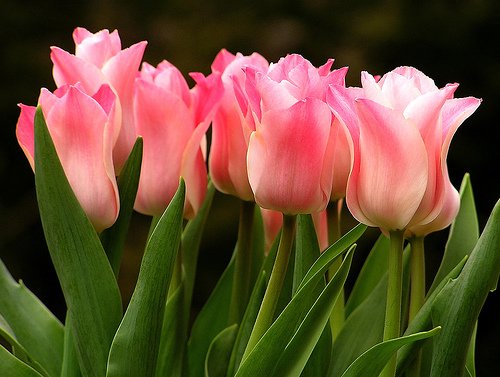APRIL 2012 Newsletter: Tulip Care & Handling
 The rich history of Tulips (Gay Smith—Chrysal March 2012)Originating in one of the least hospitable environs on earth, the foothills where China and Tibet meet Russia and Afghanistan, early tulips were hardy and well-adapted to harsh winters and parched summers of central Asia. For nomads having survived another howling, freezing, Asian winter, tulips became a symbol of life and fertility;the heralds of spring. By the early 16th century, tulips had become one of the favorite motifs of artists in the Ottoman Empire.In the autumn of 1562, tulips arrived to the Netherlands inside a Flemish merchant’s bale of fabrics shipped from Istanbul to Antwerp. History tells us that the merchant roasted, seasoned and ate most of the bulbs for dinner thinking they were some sort of Turkish onion. He tossed the remaining bulbs into his vegetable patch. The next spring, vibrant red and yellow flowers stood out among drab leaves of cabbages andkale. Much to the chagrin of the merchant, who was looking forward to another meal of Turkish onions, he realized there was something special about these brilliant flowers and contacted a friend with Horticultural savvy to come have a look. The spark of tulip interest was ignited in the Netherlands. Fortunes were made and lost as Tulipomania reached its peak less than 75 years later.Information from Tulipomania by Mike DashProcessing tulips…Poking pins in stems or adding pennies in tulip buckets is so yesterday! To maximize vase life, experience vivid colors and vibrant green foliage to the end, process tulips in cold water and Chrysal Bulb T-bags.Isn’t plain water the best tulip treatment?It’s true, bulb flowers need very little sugar to push open, but the formula is not about sugar. Bulb t-bags rebalance hormone levels disturbed at harvest, keep water pollution-free and drop the pH to dissolve air bubbles that block flow.Chrysal Bulb T-bags are a balancing actBulb t-bags re-balance cell chemistry that gets out of whack when bulbous flowers are harvested, contain minimum amount of sugar to stabilize color, and are suitable for all flowers coming from bulbs, corms, rhizomes and tubers including iris, alstroe, anemones, alliums, freesia, nerines, ranuculas and lilies.Off balance…results in symptoms of premature yellow foliage in lilies and alstroe. Irispetals curling in rather than unfurling; freesia flower combs with only one ortwo buds opening.In tulips, the hormone imbalance causes foliage to rapidly loose color vibrancy -- turning grey and yellowing. Super short vase life, and shriveling petals that soon appear transparent and look drab.Easy to use: Fill tulip buckets with ½ gallon of cold water. Drop in Bulb T-bag and add tulips. Solution will keep the water clean and flowing for 5-6 days on display.Tulip Field Notes~
The rich history of Tulips (Gay Smith—Chrysal March 2012)Originating in one of the least hospitable environs on earth, the foothills where China and Tibet meet Russia and Afghanistan, early tulips were hardy and well-adapted to harsh winters and parched summers of central Asia. For nomads having survived another howling, freezing, Asian winter, tulips became a symbol of life and fertility;the heralds of spring. By the early 16th century, tulips had become one of the favorite motifs of artists in the Ottoman Empire.In the autumn of 1562, tulips arrived to the Netherlands inside a Flemish merchant’s bale of fabrics shipped from Istanbul to Antwerp. History tells us that the merchant roasted, seasoned and ate most of the bulbs for dinner thinking they were some sort of Turkish onion. He tossed the remaining bulbs into his vegetable patch. The next spring, vibrant red and yellow flowers stood out among drab leaves of cabbages andkale. Much to the chagrin of the merchant, who was looking forward to another meal of Turkish onions, he realized there was something special about these brilliant flowers and contacted a friend with Horticultural savvy to come have a look. The spark of tulip interest was ignited in the Netherlands. Fortunes were made and lost as Tulipomania reached its peak less than 75 years later.Information from Tulipomania by Mike DashProcessing tulips…Poking pins in stems or adding pennies in tulip buckets is so yesterday! To maximize vase life, experience vivid colors and vibrant green foliage to the end, process tulips in cold water and Chrysal Bulb T-bags.Isn’t plain water the best tulip treatment?It’s true, bulb flowers need very little sugar to push open, but the formula is not about sugar. Bulb t-bags rebalance hormone levels disturbed at harvest, keep water pollution-free and drop the pH to dissolve air bubbles that block flow.Chrysal Bulb T-bags are a balancing actBulb t-bags re-balance cell chemistry that gets out of whack when bulbous flowers are harvested, contain minimum amount of sugar to stabilize color, and are suitable for all flowers coming from bulbs, corms, rhizomes and tubers including iris, alstroe, anemones, alliums, freesia, nerines, ranuculas and lilies.Off balance…results in symptoms of premature yellow foliage in lilies and alstroe. Irispetals curling in rather than unfurling; freesia flower combs with only one ortwo buds opening.In tulips, the hormone imbalance causes foliage to rapidly loose color vibrancy -- turning grey and yellowing. Super short vase life, and shriveling petals that soon appear transparent and look drab.Easy to use: Fill tulip buckets with ½ gallon of cold water. Drop in Bulb T-bag and add tulips. Solution will keep the water clean and flowing for 5-6 days on display.Tulip Field Notes~
- Unlike most flowers, tulips drink just fine through callous stem tissues as long as the flowers have not been held dry for longer than 3-4 days
- Keep tulip sleeves in place until flowers have hardened up to insure upright stems
- Never mix daffs with tulips. Daffodil sap kills tulips fast
- Use Bulb T-bags and cold water to prep display buckets for all bulbous flowers

